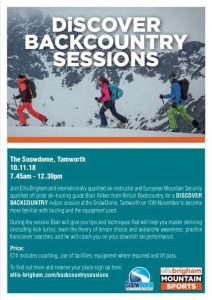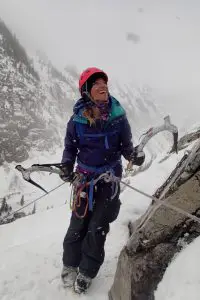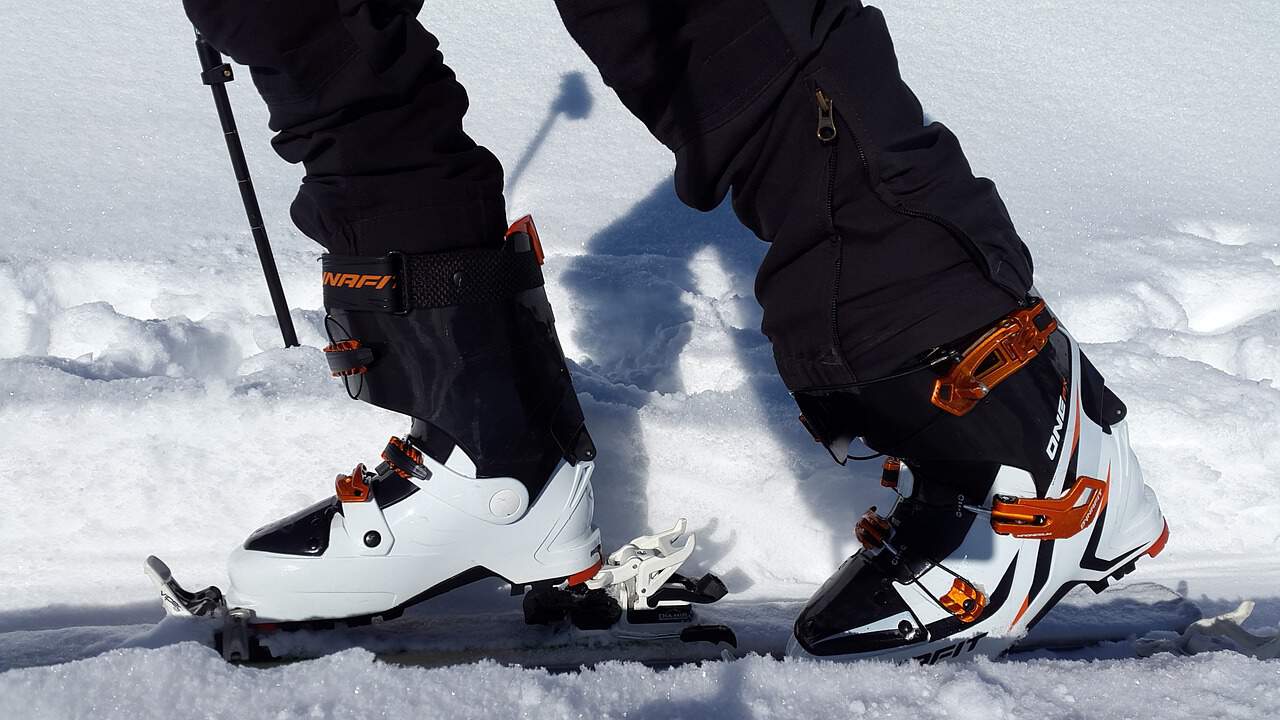In the winter mountains are about the downhill bit – or are they?
One of the things that we discovered that motorhome skiing exposes you to is a world of opportunities in the mountains that take you away from the piste and into the heart of the landscape – into the backcountry.
Back in the day, we used to call it off-piste – now the cool kids call it backcountry and it occupies a niche where the hippest cats on the mountain lurk.
Actually, you don’t have to be a freeride world champion, own a selection of belay harnesses, know how to tie a bowline or know where Monterosa is to have a go at this and get your scouts badge for being a badass backcountry rider. No, you can be an increasingly cautious girl with no desire to use a transceiver for real, who would rather not be the subject of another book or movie called ‘lost in the wild’.
James and I have been desperate to get ‘into’ backcountry since we gazed enviously into the garage of Frank – a motorhomer and mountain guide we met in Vaujany in January. It looked more like an Ellis Brigham outlet store than a locker, with crampons and snowshoes and ropes and things that made him look as intrepid as we discovered he is.
Damn Frank. Now we need to add alpinism to our list of ‘things to do in the mountains’.
Why adding strings to your alpine bow is a good idea
 So yesterday morning, we set off at some ungodly hour, surely forgetting a sock or a ski pole or some essential ski item in our blurry haze and jumped in our truck headed for the Midlands. Tamworth to be exact. We wanted (or I wanted actually) to break our backcountry cherry before we head out for our winter in the Pyrenees in a few weeks time, as the alternative is to be subjected to one of James’s ‘screw it let’s do it’ escapades where we ‘wing it’. Nope – that’s not how to do things that could end in death by stupidity.
So yesterday morning, we set off at some ungodly hour, surely forgetting a sock or a ski pole or some essential ski item in our blurry haze and jumped in our truck headed for the Midlands. Tamworth to be exact. We wanted (or I wanted actually) to break our backcountry cherry before we head out for our winter in the Pyrenees in a few weeks time, as the alternative is to be subjected to one of James’s ‘screw it let’s do it’ escapades where we ‘wing it’. Nope – that’s not how to do things that could end in death by stupidity.
We wanted to learn how to ski backcountry because not only does it open your eyes to untouched parts of the mountain, but also because our homestead for the winter isn’t ski to the door and we don’t always want to have to load up the truck to get a ski-fix.
If you’re in a motorhome skiing, you’ll have so many more options in terms of places to stay – the smaller ski stations and places off the beaten track where being able to ‘skin’ a bit will give you the chance to ski fabulous terrain and you’ll save a wad of cash on lift passes too. Add a set of snowshoes to your kit list and you’ll never be cooped up on a snow day either.
Progressing your skiing, isn’t just about nailing those parallel turns. Learning to ski backcountry as a new skill will also help you develop downhill skiing (what goes up must come down and all that) and perhaps most importantly, your mountain awareness.
Our end goal is to be competent enough to consider undertaking the legendary Haute Route or join a hut-to-hut touring party at some time by the end of the season – a whole subculture of skiing where the real adventures happen.
Backcountry skiing for women

Let’s rip this plaster off. That word ‘backcountry’ evokes images of adrenaline junkies tumbling down chutes, skiing the steepest steeps and spitting words like ‘rad’ in the lens of a GoPro. If not that, then stories of mountaineers being lost of days, avoiding being scoffed by wolves and surviving on a tipple of brandy and a squashed lion bar until help arrived in the form of a helicopter.
This is enough to put any normal girl off the idea of backcountry skiing.
It’s not like that. Much to my surprise, our fantastic coach Blair (who’s somewhat of a guru in the industry) explained that for the most part, ski touring parties (you DO NOT do this on your own), rarely enter avalanche terrain (why would you) and moreover, actively avoid anything over 27º in steepness because it’s just not fun unless you’re a bit unhinged (Blair falls into this category) . We can leave all that crazy stuff for the RedBull massive.
Despite our course presenting only a brief preview of the discipline, I left with the following:
- Skinning is far easier than it looks (this is walking uphill on skis with a free rear binding)
- Skinning uphill is a leveller – there’s only so fast you can travel and if you’re used to being left on the hill has your fearless partner jettisons into the abyss down piste, you’ll find not only will you be in a far more social setting but much of the time you’ll actually be able to have a reasonably normal conversation
- It’s much less macho than downhill skiing
How to learn backcountry skiing
This has become far easier with the forethought of one of the biggest names in the ski-business, Ellis Brigham. Noticing an increase in regular customers (not those gnarly ones with a perma-tan), asking about ski touring equipment, they sought support from Blair Aitken who is one of the big names in backcountry touring in the UK. They set up a few pilot courses to introduce total newbies to the sport of backcountry touring.
Here’s a little peek into the world of backcountry.
And that’s where James and I found ourselves yesterday. In Tamworth.
And that’s where the idea really appealed to us. We didn’t have to invest in kit or make a commitment to haul ass to Scotland or further afield and put down some proper cash to ‘test the water’. Who knows, one or other of us might have entirely hated it and with my ankles in a pretty poor state or repair, I wasn’t sure if this alone would be a deal breaker.
10 of us, which included Roger from our Motorhome skiing and Boarding FB group, hit the ground running at 07.45 with a 101 lesson in backcountry kit, whilst Blair fitted our own alpine boots (nothing special required) to pre-allocated touring skis equipped with touring bindings.
A quick intro and we were all on the slope, learning how to apply skins to our skis (essentially just ski gloves that make it possible to grip the snow – pretty important for the next stage).
If I ever doubted that it was possible for a mortal to ascend a 20º slope directly pointing uphill on skis, my mind was about to be blown.
With zero faffing, we were shown the basic movements required, in we clipped, and off we went. Uphill. I know, voodoo right?
5 hours later and I know this mountain activity ticks a lot of boxes for me and James and we’ll will be taking this seriously.
About the kit
These courses are designed to encourage you to take up a sport that a) you will love and b) requires you to invest in kit and there is no shame in that – bravo Ellis Brigham, you have been awarded a gold star in marketing. The courses are outrageously good value and must be subsidised because just accounting for the slope time (you’ll get a few hours actually on your planks), specialist kit hire and coaching, is a big investment for them and the course itself only costs £74 per person.
If you come out of a course wanting to take it more seriously, you’ll need some kit (you could hire it but if you’re really keen and you have a motorhome, your own is the way forward) and Ellis Brigham have a really good range, picked by their super knowledgeable people. There is a second-hand market but with backcountry being a little less run of the mill, you’re not going to find quite as much on offer as you will with regular alpine skiing equipment.
What you need and what you don’t:
First off, it’s important to NOT BE INTIMIDATED by this seemingly long and expensive list. You can get an adequate set up for less than a couple of weeks ski pass in Chamonix.
Obviously, the advice is to get kit designed specifically for the job but…we’ll start with boots.
Boots – not essential
You may have heard of pin bindings and touring boots. These are the way things are going and depending on how seriously you are looking to take this, you might want to think about getting a separate set of boots – they’re different.
However, totally unnecessary for anyone who might only do one or two trips a season. Your alpine boots are fine and there is an arguement, better the devil you know!

Skis and bindings – do need
This is where you might want to spend your cash. Nice backcountry skis will revolutionise your experience both up and down the mountain and who doesn’t want a reason to have a second set of skis?! You can get touring bindings that work perfectly well with your alpine boots which facilitate the all-important free heal.
Deadly serious folks need to start researching shift bindings and you might want to join the British Backcountry FB group if you fancy listening in on kit chat.
Poles – might need
It’s worth getting some adjustable poles. Varying terrain and a bunch of other very valid reasons means that being able to adjust the height of your poles is pretty important. You’re also going to want the big powder baskets for the bottom but most of them come with those anyway. Be careful – they aren’t quite the same as a hiking pole (which usually come as a single pole and you’re definitely going to need two) so look at the specialist touring poles.
Skins and Harscheisen (or ski crampons) – do need
Skins we were assured can last for years and years if looked after properly, they do fit your skis specifically, and they are surprisingly costly – setting you back over £100 and you can spend a lot more than that. However, these are the equivalent of snow tyres and you know how we feel about those so we’ll leave it at that!
Ski crampons are pretty specific too and you can’t trim them in the same way that you can a skin! They’re what’s going to allow you to tramp across that hideous evil they call ice.
Safety Equipment – you can hire
We’re all starting to think more about this anyway and so this isn’t just backcountry specific stuff. At a basic level you need a transceiver. Step it up and you need a probe and an avalanche shovel, after that you’re into serious expenditure and needing a Sherpa to carry your expedition kit. However, f you’re starting to take on backcountry in a serious way then there is a whole world of things you can re-mortgage your house for – exploding air bag back backs, trips to Norway to ski Loften and heli-drops into Alaska. That might have to be another blog!
Next steps
Demand Ellis Brigham run more of these courses. They are an excellent opportunity to try something out and a nice day out even if you choose not to pursue backcountry skiing any further. We have given our feedback (for what that’s worth) and hopefully they’ll be able to add more dates to the calendar in due course.
Once you’ve been on an introductory course, you have a few options – kit yourself out and wing it (not at all recommended!), or hire a guide or sign up for a more comprehensive course in resort where you can start practicing some of the basics and get some of the true benefits in the mountain air! Or, for those of you with an adventurous spirit, you can look into some of the operators in Scotland which run incredible tours for all experience levels and what’s more, the season extends into June when motorhome skiing is usually a thing of the past.
We’re obviously rooting for Blair – he took something that was really intimidating to me and gave me the confidence to think that skiing backcountry is something that I can do. And perhaps more importantly, something that James and I can do together and both get equal kicks out of it. Check his website – British Backcountry and do have a look at his Facebook group because we all like a lurk in a FB to get the lie of the land.
One thing I know for sure if that we’re welcome in this world. If you’re interested in seeing what backcountry kit looks like and what it costs, click on the Ellis Brigham link below.
